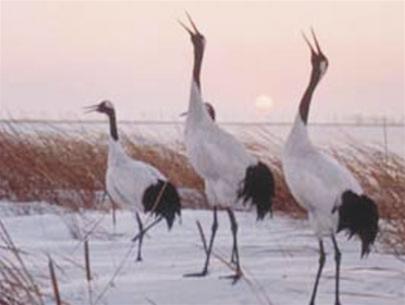Grus Japonensis red hat cranes
In China, Korea, and Japan, people often see pictures of red hat cranes along with spicy old parts, giving birth to long life. In fact, the red hat still refers to the legend of a large waterfowl that lives in the lagoon, shallow water, which has nothing to do with the pine tree. Moreover, its lifespan is only 20-30 years, nothing is long lived.

Grus Japonensis red hat cranes
Red hat crestfallen personality, beautiful morphology, kind of tall with 3 long: long beak, long neck and long legs. When standing, they are over 1m high. The coat is white, throat, neck and cheeks dark brown. The black wing feathers are covered in white tail feathers. Especially the top of the head stands out with crimson like a red hat, so it is called a red hat.
The red hat is a typical migratory bird, every year according to the changing seasons of the weather, they migrate in the North of the country in a regulated manner. They often park in flocks on a wide reed yard or in a pond of many grasses that grow up to eat shrimp, fish, shellfish and plants. Every April, they choose couples, early morning or evening, they often hear them calling for you, distant echoes 2-3km away. When choosing a male partner to actively raise the neck to spread the wings, the mouth calls "muscle" without end, the female children jump "a muscle" to answer. Both parties dance and sing like this until they decide to be a couple, and will live together for the rest of their lives.
Red cranes often lay eggs in the summer of April. They do not have a clear period of nesting, just before laying new hours to select the dense grass for nesting. After laying off, the female is lying in the nest, the male is hanging around the nest to protect. About 1 month of hatching eggs, during that time when the offspring leave the nest, the males hatch.
In May, the young eggs broke out, after 20 hours stumbling and swimming. After 3 months, it became a large crane, free to fly and search for prey. From the upper and middle of October, they followed their parents into a rectangle (/) or the first word (-) from the North to the South, starting a journey of thousands of kilometers. It was not until March of the following year that he returned to his homeland.
According to survey statistics, the total number of wild red hat cranes worldwide is only about 1,200, listed as protected animals.
- The life of the gray crane
- Sarus cranes leave Vietnam to Cambodia
- The crocodile approached the cranes and the unbelievable ending later
- Discover rare black neck cranes in India
- Sarus cranes return to live on Kien Giang land
- The life of a crane
- Detecting strange birds first appeared in Muong Nhe
- How is the foundation of a bridge built?
- The number of migratory cranes in the Mekong Delta is less and less
- Tram Chim-Dong Thap: Cranes return more and more
- Video crane 'drop' Airbus A-320 aircraft
- See pictures of migrant animals
 Animal 'suffering' after hibernation
Animal 'suffering' after hibernation Why do goats climb well?
Why do goats climb well? Scientists were surprised to see chimpanzees eating turtles
Scientists were surprised to see chimpanzees eating turtles Giant catfish died deadly due to drought in Thailand
Giant catfish died deadly due to drought in Thailand